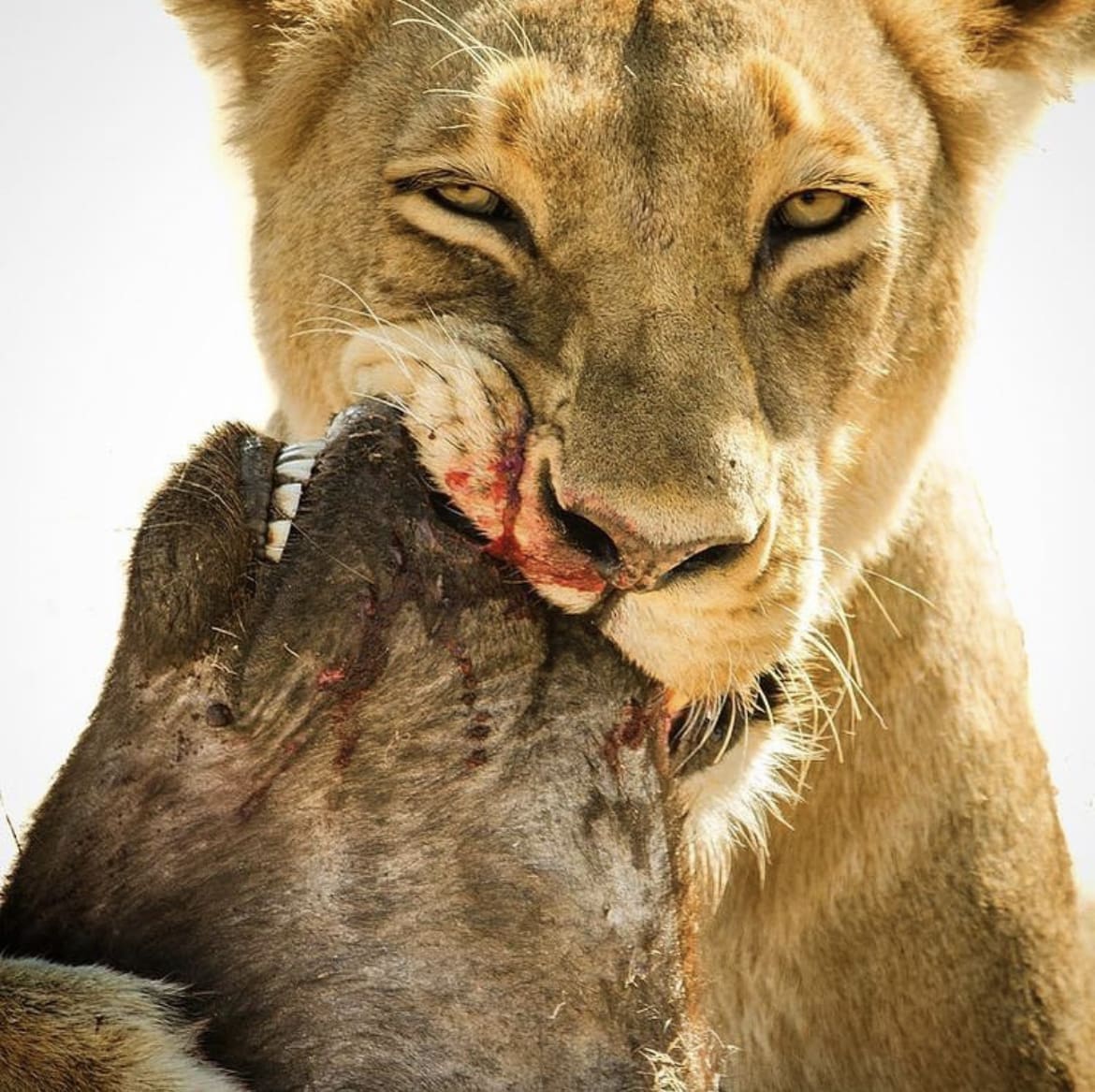Ready to dive deep into the world of one of Africa’s most underrated stars? I’m talking about the wildebeest, folks. Not just any wildebeest, but the blue ones.
These creatures are more than just a staple of wildlife documentaries; they’re the heart and soul of the African savannah. So, grab your virtual safari hat, and let’s embark on this wild journey.
What is the Wildebeest?
First off, what exactly is a wildebeest? If you’re picturing a confused mix between a cow and a deer with an identity crisis, you’re not entirely off base. Wildebeests, also known as gnus, are a sight to behold with their shaggy manes and bearded chins, roaming the vast plains of Africa.
These guys are the lifeblood of the savannah, playing a crucial role in the ecosystem. They’re not just animals; they’re ecosystem engineers, grazing the land to maintain healthy grasslands and serving as a moveable feast for predators. Talk about a tough life, right?
Blue vs. Black Wildebeest
Now, let’s clear up the confusion: blue vs. black wildebeest. It’s like comparing apples and slightly darker apples. The blue wildebeest, or the Connochaetes taurinus if you want to get fancy, sports a silvery-blue sheen, hence the name.
They’re the ones you see making the epic treks across the Serengeti. On the other side, we have the black wildebeest, or Connochaetes gnou, rocking a darker coat and calling the southern parts of Africa home. While they share a family tree, their lifestyles and habitats are pretty different, showcasing nature’s flair for variety.
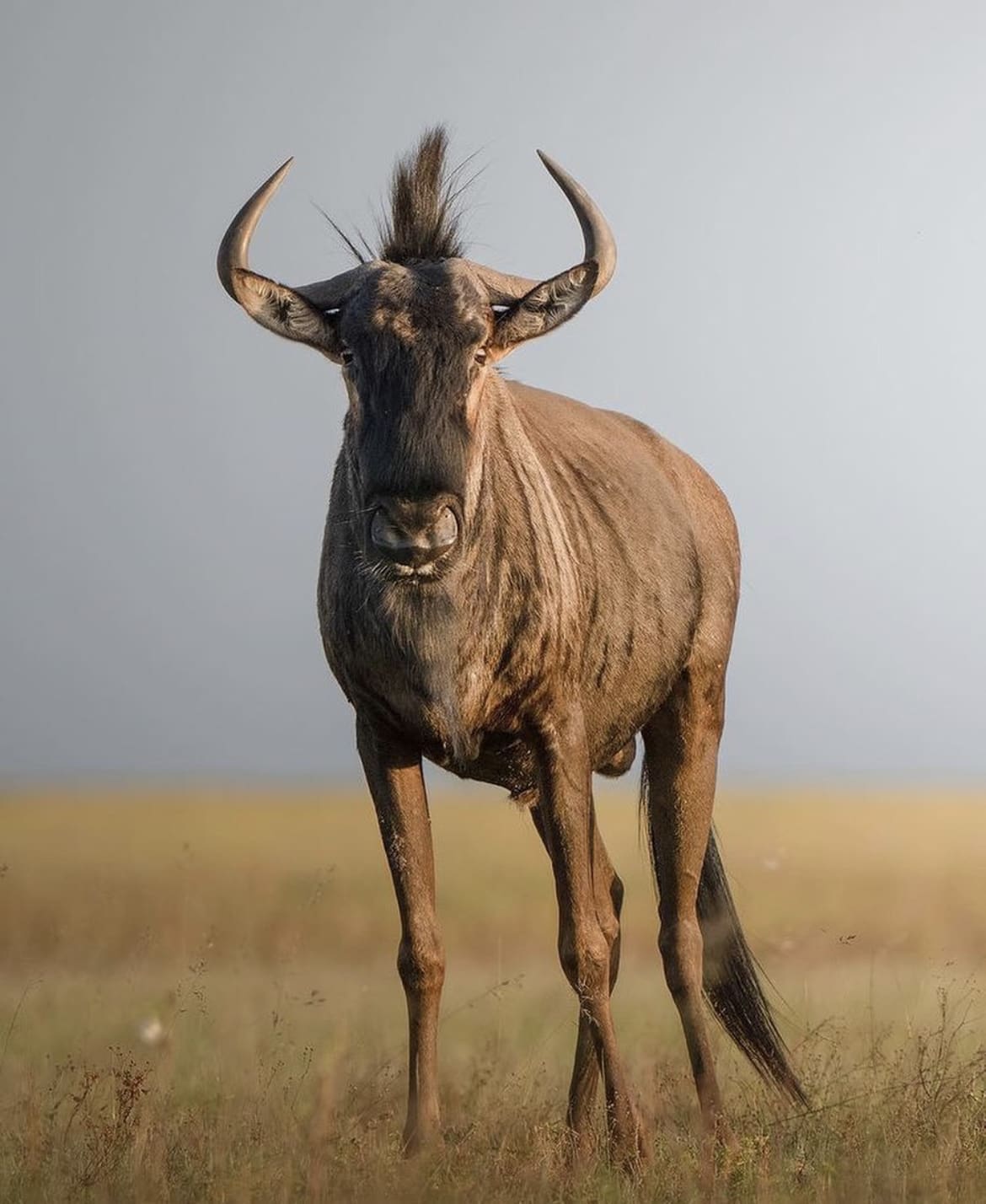
What Do Blue Wildebeest Look Like?
Let’s zoom in on the blue wildebeest. Picture this: a creature that looks like it’s been assembled from parts of other animals. They’ve got the mane of a horse, horns that could belong to a buffalo, and a face that screams “antelope.”
Their bodies are built for endurance, not for winning beauty contests. Blue wildebeests have this unique silvery-blue coat that glistens under the African sun, muscular necks, and slender legs that seem to never tire. Don’t let their somewhat awkward appearance fool you; these animals are built for survival.
How Big Are Blue Wildebeest?
Ever wonder how big these creatures get? Imagine standing next to a motorcycle that’s alive, moving, and has horns. Yeah, that’s about the size of an adult blue wildebeest. They can weigh up to 600 pounds (that’s about four adult humans) and stand around 4.5 feet tall at the shoulder.
When it comes to length, they can stretch up to almost 8 feet from nose to tail. So, next time you’re feeling a bit sluggish about hitting the gym, just remember: a blue wildebeest could probably outlast you in a marathon.
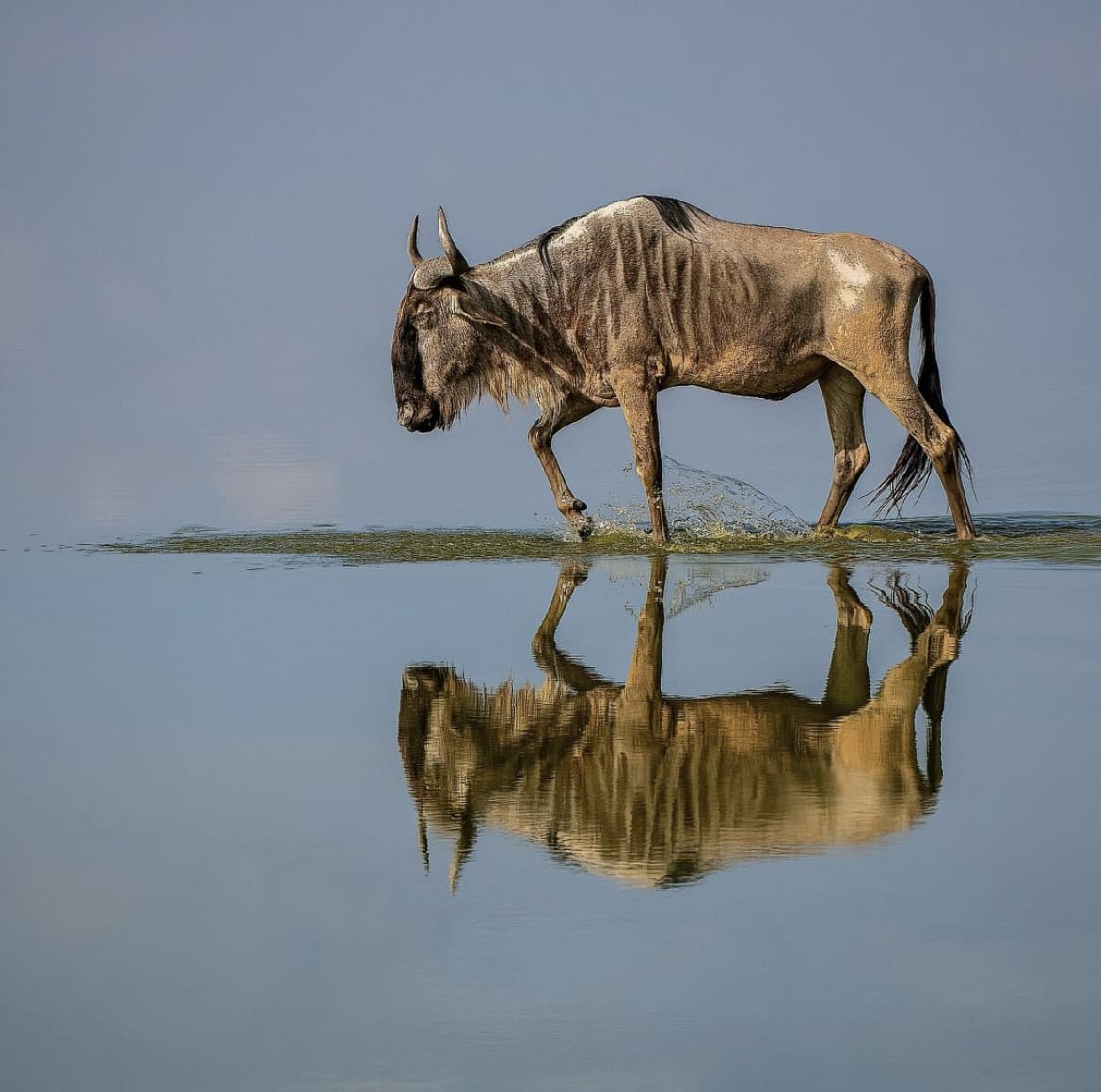
Blue Wildebeest Horns
And we can’t talk about wildebeests without mentioning their iconic horns. These aren’t just for show; they’re a vital tool for survival. Both males and females sport these curved beauties, which can span up to 30 inches.
They use them for defending themselves against predators and for sparring matches during mating season. It’s like nature’s version of a multi-tool, equally handy for digging, fighting, and making a point (pun intended).
What Do Blue Wildebeests Eat?
Moving on to the wildebeest diet – it’s all about that grass. These guys are the ultimate vegans, grazing their way through the plains in an endless quest for the greenest of pastures.
They’re not picky eaters; they’re bulk feeders, consuming a variety of grasses to keep their energy up for those long migrations. It’s a simple diet, but it’s fuel for their epic journeys.
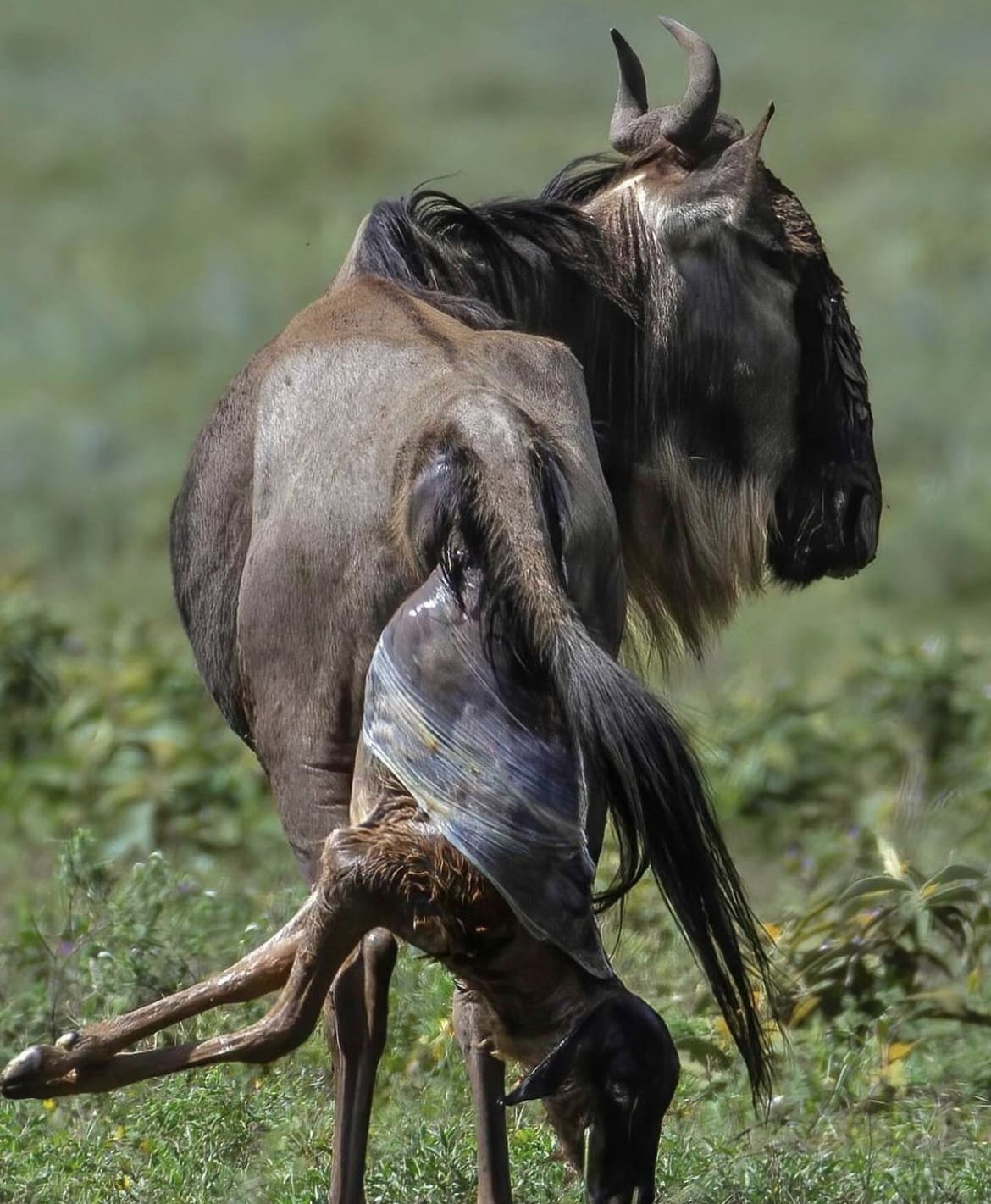
Do Blue Wildebeests Live in Herds?
Absolutely, and there’s strength in numbers. Blue wildebeests are social animals, forming herds that can number in the thousands. It’s like living in a moving city, where everyone shares the goal of finding food and water.
These herds offer protection from predators and a sense of community. It’s not just about survival; it’s about thriving together. The dynamics within these herds are fascinating, with a mix of family groups and bachelor clubs. It’s wildebeest society on the move, each member playing a role in the greater good of the herd.
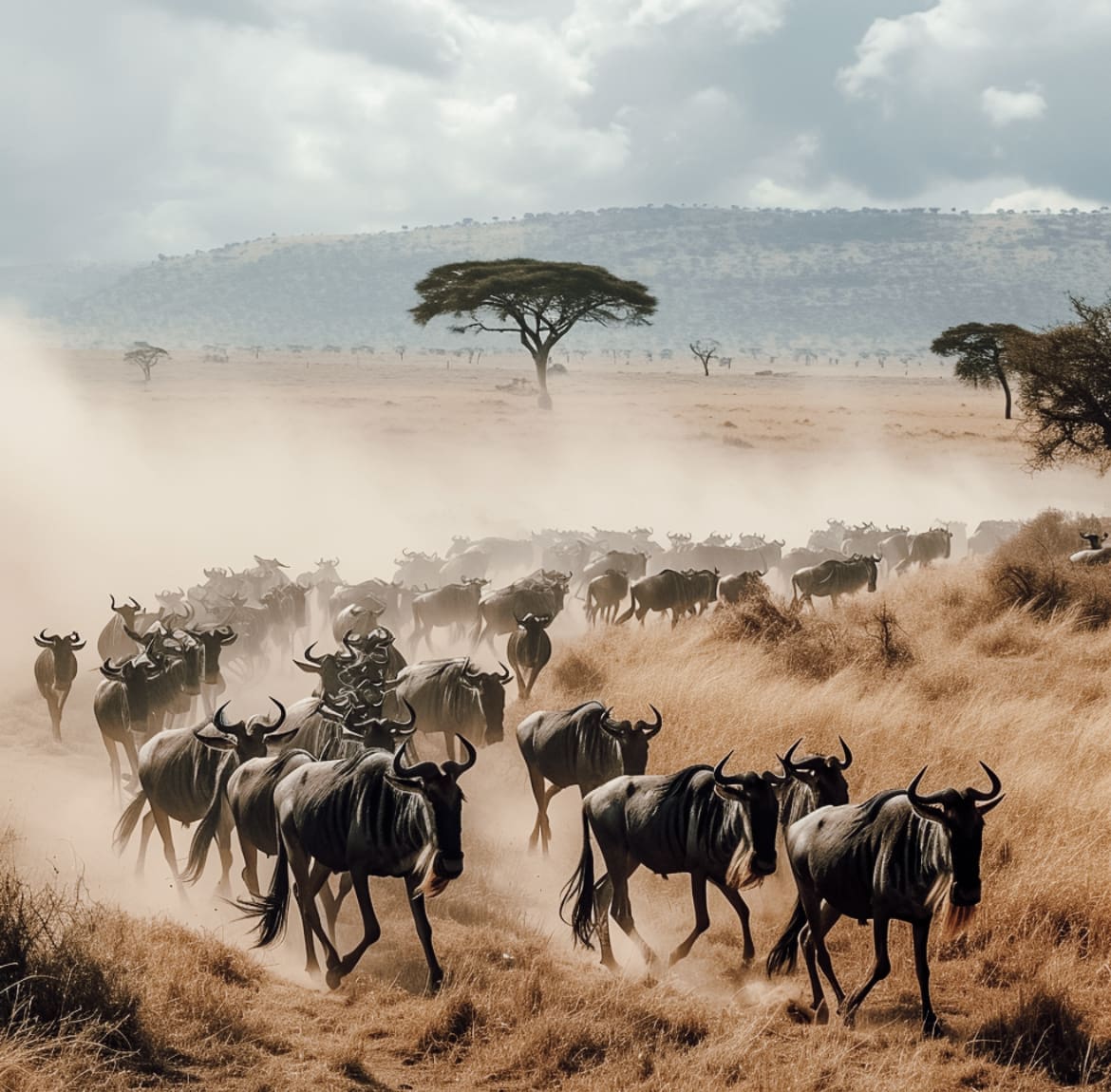
Are Blue Wildebeest Aggressive?
You might think that living in the wild would make these creatures fierce and aggressive, but blue wildebeests are relatively chill unless threatened. Sure, males can get a bit feisty during the mating season, showing off their horns in battles of strength and dominance.
But generally, they’re all about that peaceful grazing life. However, don’t mistake their calm demeanor for weakness. When it comes to protecting their young or facing off with predators, they can put up a formidable defense. It’s all about picking the right battles in the savannah.
Wildebeest Migration
Each year, over 1.5 million blue wildebeests, accompanied by hundreds of thousands of zebras and gazelles, embark on a circular trek spanning approximately 1,800 miles through Tanzania’s Serengeti and Kenya’s Masai Mara. This journey is driven by an ancient, unerring instinct to follow the rains, ensuring that they’re always grazing on fresh, nutritious grasslands.
The migration begins in the southern Serengeti, where in the lush, green pastures, blue wildebeests give birth to around 500,000 calves over a short period, usually between January and March. This mass birthing is a strategy for survival; with so many calves born at once, predators can only catch a fraction of them.
As the dry season sets in around late May or early June, the vast herds start moving northward, facing numerous challenges. One of the most dramatic moments of the migration is the crossing of the Grumeti and Mara rivers, where crocodiles lie in wait. These crossings are perilous and chaotic, with wildebeests plunging into the turbulent waters, driven by a primal urge to reach the other side where fresh grazing awaits.
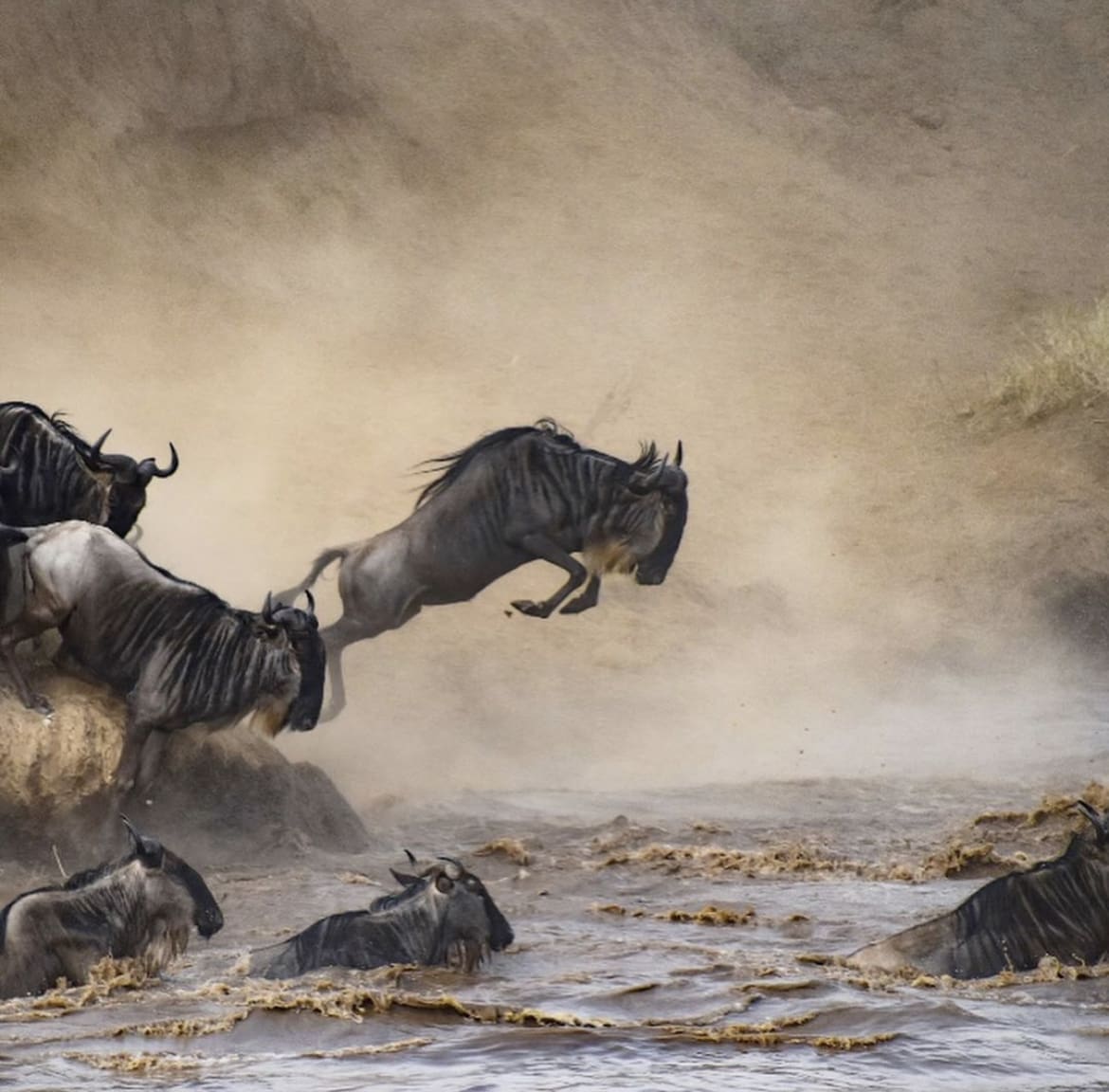
The wildebeests’ journey is fraught with danger, not just from the rivers’ deadly residents but also from lions, cheetahs, and hyenas that follow the herds, picking off the weak, the old, and the unlucky. Yet, this migration is vital for the savannah’s health, rejuvenating the land and ensuring a balance within the ecosystem.
By September or October, the herds reach the lush plains of the Masai Mara, where they spend the dry season grazing. However, as the short rains begin in late October or November, the wildebeests sense that it’s time to make their journey back to the Serengeti, where the cycle will begin anew with the calving season.
This migration is not just a journey for survival; it’s a key event for the Serengeti-Mara ecosystem, supporting a vast array of carnivores and scavengers and maintaining the health of the grasslands. It’s a spectacle of nature that highlights the interconnectedness of life and the environment, showcasing the resilience and adaptability of the blue wildebeest.
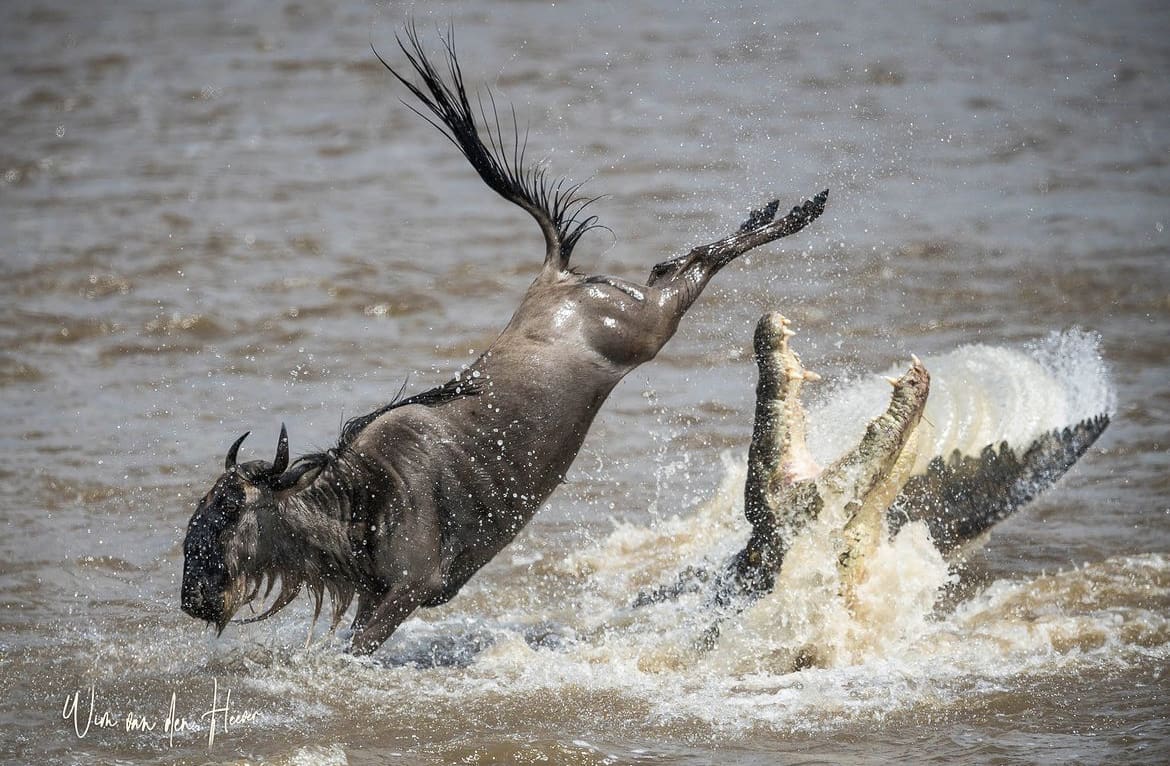
Where Do Blue Wildebeest Live?
Blue wildebeests are the nomads of the African plains, primarily found in the Serengeti in Tanzania and the Masai Mara in Kenya. These locations are not just random spots on a map; they’re carefully chosen stages for the greatest show on Earth.
The blue wildebeest’s habitat is defined by the availability of fresh grazing lands and water sources. They’re constantly on the move, following the rains in a never-ending quest for the lush life. These areas provide not just the basics of survival but a backdrop for the circle of life that unfolds in dramatic migrations and daily survival.
How Many Blue Wildebeest Are There in Africa?
When it comes to numbers, blue wildebeests are doing pretty well for themselves, with estimates putting their population at over a million. It’s a testament to their resilience and the success of conservation efforts in their habitats.
However, these numbers aren’t static; they fluctuate with the seasons, predation, and human impacts on their environment. The great migrations are not just spectacular; they’re a pulse check on the health of the wildebeest population and the ecosystems they traverse.
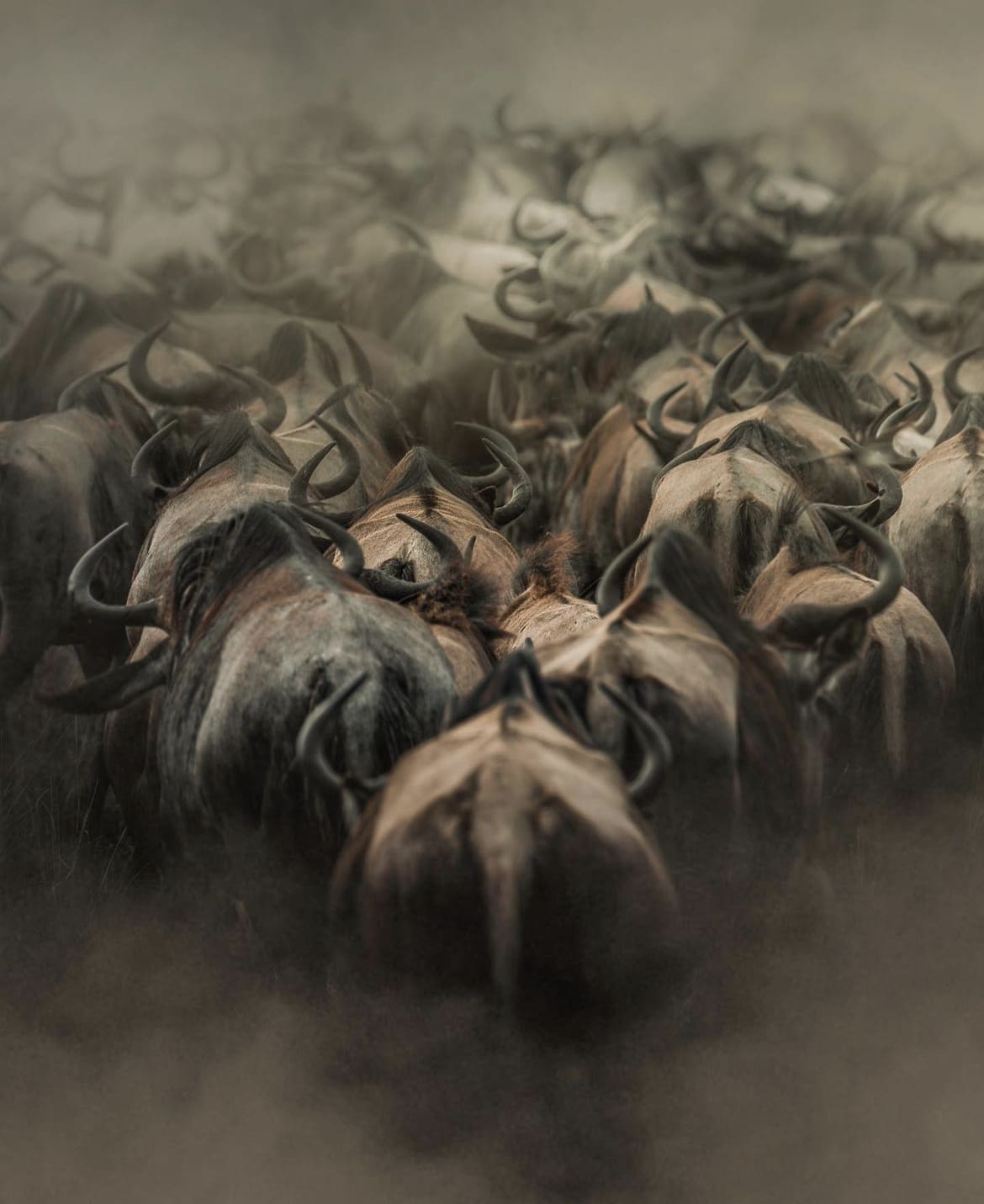
Are Blue Wildebeests Endangered?
The good news? Blue wildebeests are currently not considered endangered. They’re listed as Least Concern by the IUCN, thanks to their large numbers and successful management in protected areas.
But don’t let that status fool you into complacency. These animals face ongoing threats from habitat loss, climate change, and human encroachment. Their survival is a delicate balance, dependent on the continued efforts to protect the vast landscapes they call home.
Threats to Blue Wildebeest in the Wild
Life on the savannah is no walk in the park, and blue wildebeests face their fair share of challenges. Beyond the natural predators that keep them on their hooves, human activities pose significant threats.
Habitat loss due to agriculture and development, fences that block traditional migration routes, and climate change affecting rainfall patterns and grassland health are just the tip of the iceberg. Each of these threats can disrupt the delicate ecosystem balance, proving that the survival of the blue wildebeest is intertwined with the health of their environment.
Where to See Blue Wildebeest on Safari
For those itching to experience the majesty of the blue wildebeest firsthand, there’s no place like the Serengeti in Tanzania and the Masai Mara in Kenya. These iconic destinations are the stages for the wildebeest’s annual migration, offering spectacular views of nature’s grandest procession. Planning your visit between July and October maximizes your chances of witnessing the dramatic river crossings, a highlight of the migration.
However, the Serengeti offers more than just the migration. Visiting outside the peak migration months allows for a different but equally compelling experience, as wildebeest herds roam the vast plains in search of green pastures. The Ngorongoro Crater in Tanzania also provides a unique backdrop for observing wildebeest alongside a dense concentration of predators.
Tips for Spotting Blue Wildebeest in the Wild
Spotting blue wildebeest, especially during the migration, requires a mix of timing, patience, and a bit of luck. Here are some tips to enhance your safari experience:
- Early Morning or Late Afternoon: These are the times when animals are most active. The soft light also makes for great photography.
- Stay Quiet and Patient: Wildlife can be unpredictable. Sometimes, the best sightings come to those who wait.
- Guided Tours: Experienced guides know the best spots and can interpret animal behavior to predict movements, enhancing your chances of a memorable encounter.
- Respect the Wildlife: Always keep a safe distance to avoid disturbing the animals. Remember, we’re guests in their home.

Facts about the Blue Wildebeest
The blue wildebeest is not just another face in the crowd; it’s an animal of incredible intrigue and resilience. Here are some facts that highlight their unique place in the wild:
- Social Creatures: Wildebeest are highly social and can form herds numbering in the tens of thousands. This social structure is crucial for their survival, offering protection against predators.
- Remarkable Endurance: Wildebeest can travel up to 25 miles a day during their migration. Their journey is one of the most demanding tests of endurance in the animal kingdom.
- A Keystone Species: Their grazing habits are vital for maintaining the health of grasslands, making them a keystone species in their ecosystem.
- Survival Instincts: Within minutes of being born, wildebeest calves are up and running, ready to join the herd in the great migration. This rapid development is vital for their survival amidst predators.

Myths about the Blue Wildebeest
Certainly, let’s dispel some of the myths about the blue wildebeest with a concise bullet point list:
- Sixth Sense for Rain: It’s a myth that wildebeests have a mystical ability to predict rainfall. Their migration patterns are influenced by the availability of green pastures, which follow seasonal rain patterns, rather than an innate ability to sense weather changes.
- Blind Followers: Contrary to the belief that wildebeest blindly follow the herd into danger, their migration is a complex decision-making process. It’s guided by the collective memory and experiences of the herd, optimizing their survival and not just a simple follow-the-leader scenario.
- Inability to Survive Alone: Some believe that wildebeests cannot survive outside their herds. While they are highly social animals that rely on the herd for protection against predators, individuals can survive on their own. However, their chances of survival increase significantly as part of a group.
- Aggressive by Nature: Another myth is that blue wildebeests are inherently aggressive. In reality, they are quite peaceful and prefer to avoid conflict. Males may show aggression during mating season, but this is more about competition than a general disposition towards aggression.
- Poor Swimmers: There’s a misconception that wildebeests are poor swimmers, which is why many drown during river crossings. While river crossings are dangerous and some wildebeests do perish, they are actually capable swimmers. The high casualty rates during crossings are more due to the sheer numbers attempting to cross, predatory attacks, and panic, rather than an inability to swim.
Dispelling these myths helps us appreciate the complexity and adaptability of the blue wildebeest, showcasing their remarkable traits and survival strategies in the wild.

